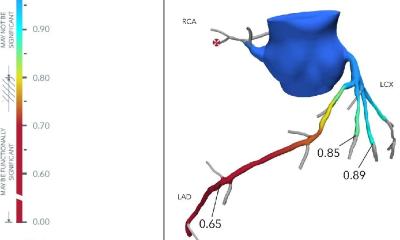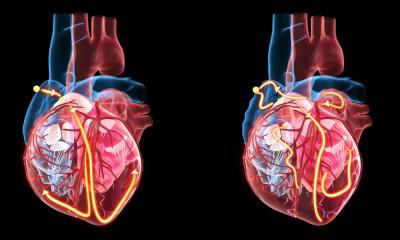Genetic lipoprotein disorders are frequently seen in patients with premature coronary artery disease. An example of strong genetic predisposition is the disorder: familial hypercholesterolemia, where a single gene defect (the low density lipoprotein receptor) contributes to most of the familial expression of CAD. Conversely, lifestyle, diabetes, dyslipidemia, cigarette smoking and hypertension contribute to most of the population-attributable risk in the large, international INTERHEART study of acute myocardial infarction (heart attacks). The identification of single gene disorders may pave the way to a better understanding of complex metabolic pathways. Understanding the genes that regulate high density lipoprotein (HDL) metabolism may lead to novel therapeutic approaches. This has been emphasized by two therapeutic approaches for the treatment of CAD:
- The infusion of apo AI containing proteoliposomes, using wild-type or a mutant form of apo AI, apo AIMilano, in patients with acute coronary syndromes;
- The long-term treatment of subjects with low HDL-C with the cholesteryl ester transfer protein (CETP) inhibitor Torcertapib. While Torcetrapib proved to have off-target toxic effects, two other CETP inhibitors (Anacetrapib and Delcetrapib) are being tested clinically. Experimentally, however, CETP inhibitors may not reduce atherosclerosis
Novel therapeutic approaches using agonists of the LxR/RxR pathway to up-regulate the ABCA1 transporter, or the transcriptional regulation of apo AI, are being explored.
Epidemiology of HDL and risk of coronary artery disease CAD risk
Plasma (or serum) level of HDL-C is a continuous and graded negative cardiovascular risk factor. Most international CAD prevention guidelines define HDL-C as a categorical risk factor and the absolute level of HDL-C is used in a multivariate model to predict cardiovascular risk and determine the need and intensity of preventive therapies. A low HDL-C is considered a diagnostic criterion for the metabolic syndrome.
To underlie the importance of plasma lipoproteins in the pathogenesis of CAD and acute myocardial infarction, the largest case-control study of myocardial infarction (INTERHEART) has shown that the apo B/apo AI ratio (respectively an index of atherogenic lipoproteins and protective lipoproteins) accounts for approximately half (49%) of the population-attributable risk of acute myocardial infarction. The prevalence of a low HDL-C in patients with CAD has been examined in several case-control and prospective studies. It is estimated that approximately 40% of patients with premature CAD have a low HDL-C and this represents the most common lipoprotein disorder in patients with CAD. Most patients with a low HDL-C have multiple cardiovascular risk factors and features of the metabolic syndrome, with obesity (predominantly abdominal), elevated plasma triglyceride levels, high blood pressure and hyperglycemia, insulin resistance or diabetes. Despite the strong association between metabolic disorders and HDL-C, plasma levels of HDL-C are strongly genetically determined. Experimental evidence shows that the atheroprotective effects of HDL are pleiotropic and extend beyond removing cholesterol from lipid-laden macrophages in the atherosclerotic plaque. HDL are known to have anti-inflammatory effects, to prevent oxidation of low-density lipoproteins (LDL), possess anti-thrombotic properties, modulate vasomotor tone and may improve endothelial cell survival (by preventing apoptosis), migration and proliferation. Nonetheless, the major cardio-protective effect of HDL has been attributed to its key role in reverse cholesterol transport, a process in which cholesterol from peripheral tissues such as foam cells is selectively returned to the liver for excretion in the bile. Mutations in any ofthe proteins regulating this complex metabolic pathway may potentially decrease HDL-C levels and accelerate CAD.
Genes that affect HDL-C levels
Mutations or polymorphisms in several genes have been associated with altered plasma HDL-C levels. Mutations in the cholesteryl ester transfer protein (CETP) gene are associated with increases in HDL-C whereas mutations in the apolipoprotein (apo) AI gene (the major apolipoprotein of HDL particles), or the lecithin:cholesterol acyl transferase (LCAT) gene cause a low HDL-C. Of the approximately 46 mutations affecting the structure of apo AI, not all are associated with CAD. Mutations in the lipoprotein lipase (LPL) and hepatic lipase (HL) genes also affect HDL-C levels. The identification of the ATP binding cassette A1 gene (ABCA1) as the cause of Tangier disease and familial HDL deficiency has led to a better understanding of the role of cellular cholesterol and phospholipid transport in the metabolism of nascent HDL particles. Based upon the analysis of a selected group of subjects, we estimate that approximately 10-20% of subjects with severe HDL deficiency have mutations of the ABCA1 gene. Other genes have been found in animal models to have a profound impact on HDL-C levels, although no human counterpart disorders have yet been identified.
To examine the genetic contribution to the determination of HDL-C levels, there have been at least nine published studies in twins and 14 family studies. Estimates for the heritability of plasma HDL-C levels varies between 0.24 to 0.83 and is most often quoted as approximately 0.5.
Genetics of HDL and risk of cardiovascular disease
The inverse epidemiological association between serum levels of HDL-C and risk of CAD is graded and has been validated in multiple studies. However, there is remaining controversy whether a low HDL-C should not predominantly be considered a marker of poor lifestyle (obesity, lack of exercise, hypertriglyceridemia, diet, etc.), rather than a primary causal agent for atherosclerosis in the majority of the population. Specific mutations in genes affecting HDL-C levels have had considerable discordant effects on CAD risk. For instance, mutations in the apo AI gene affecting HDL-C levels can be strongly associated with premature CAD, but apo AIMilano and apo AIParis are notable exceptions. Mutations in the LCAT gene cause a marked decreased level of HDL-C but are not considered to be associated with CAD. While loss-of-function mutations in the CETP gene cause an elevated HDL-C, cardiovascular risk does not seem decreased and may in fact be increased. Mutations in ABCA1 are associated with very low HDL-C and increase cardiovascular risk 3.5 fold in one study, but more recent data from the Copenhagen Heart Study suggests that ABCA1 mutations are not associated with increase cardiovascular risk, despite being associated with a low HDL-C. Important questions therefore remain which genetic forms of HDL deficiency confer cardiovascular risk. This has implications for the identification and treatment of patients with HDL deficiency. It remains to be determined whether a genetic form of HDL deficiency confers cardiovascular risk.
by Professor Jacques Genest









